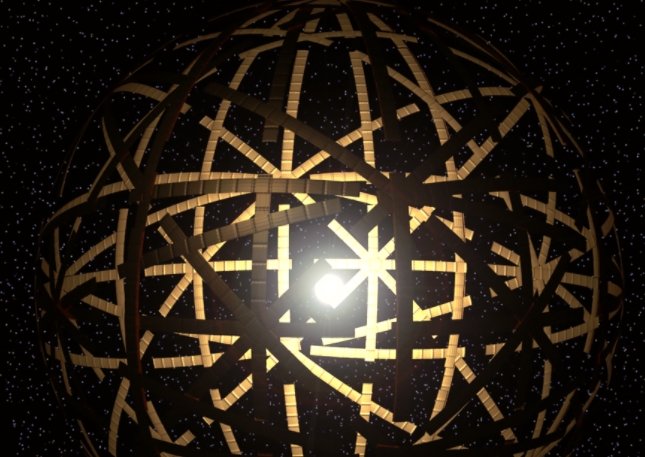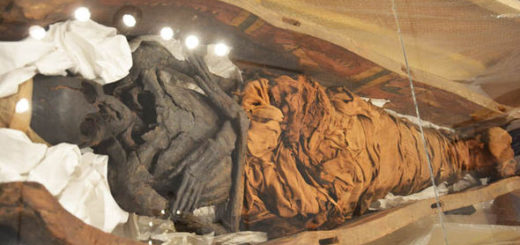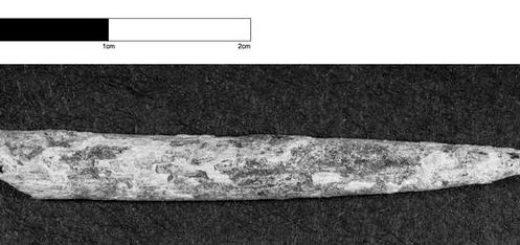A Dyson Sphere Harvests The Energy Of Stars

Earth’s biggest construction project
What if humans could harness all the sun’s energy? What if extraterrestrial civilizations have already learned to harvest the energy of stars? In 1960, physicist and astronomer Freeman J. Dyson proposed to use orbiting solar collectors to accomplish this mind-boggling feat. He first explored it as a thought experiment. Nowadays, we call these giant megastructures by the name Dyson spheres. Some astronomers want to search for them!
We’ve never seen a Dyson sphere. The idea still exists in the world of thought alone. It all started with Dyson’s two-page paper in the journal Science in 1960. The title was Search for Artificial Stellar Sources of Infrared Radiation. Dyson imagined a solar-system-sized power-collection structure as a technology that would be inevitable for advanced civilizations in the universe. He proposed that searching for evidence of the existence of such structures might lead to the discovery of intelligent life in the galaxy.
Old man with swooping gray hair in a jacket.
Freeman Dyson at the Long Now Seminar, San Francisco, October 5, 2005. Photo by Jacob Appelbaum/ Wikimedia Commons.
An array of shiny solar panets outside somewhere under a sunny sky.
First step toward a Dyson sphere? Image via langalex.
Hexogonal mirrors in orbit around a yellow star.
A Dyson sphere might be built entirely of separate mirrors, orbiting the sun and facing inward toward it. This image is a screenshot from the video below.
Many large curved strips surrounding a star.
Another artist’s concept of a Dyson sphere built by an advanced civilization to capture the energy of a star. Image via CapnHack/ BigThink.com.
The mystery of Tabby’s Star
In recent years, astronomers explored a true-to-life possibility of a Dyson sphere. It involved a bizarre star labeled as KIC 8462852 and more popularly called Tabby’s Star. The nomenclature comes from its discoverer Tabetha Boyajian. This star’s light is strange. Astronomers originally thought the star’s light might indicate a Dyson sphere. That idea has since been discarded, but the talk about the star – while astronomers were discussing it – was fascinating.
And, in 2018, other possibilities emerged. For example, there’s been a proposal to use the Gaia mission to search for Dyson spheres.
So Dyson spheres stayed strictly in the realm of science fiction or science possibility during the 20th century. But the idea of them now seems real enough to astronomers that some are scrutinizing particular stars, looking for signs of them.
What is a Dyson sphere?
Originally, some envisioned a Dyson sphere as an artificial hollow sphere of matter around a star, and Dyson did originally use the word shell. But Dyson didn’t picture the energy collectors in a solid shell. In an exchange of letters in Science with other scientists, following his 1960 Science article, Dyson wrote:
A solid shell or ring surrounding a star is mechanically impossible. The form of ‘biosphere’ which I envisaged consists of a loose collection or swarm of objects traveling on independent orbits around the star.
A bright dot with a large ring of white dots around it.
The central dot in this image represents a star. The simplest form of Dyson sphere might begin as a ring of solar power collectors, at a distance from a star of, say, 100 million miles. This configuration is sometimes called a Dyson ring. Image via Wikimedia Commons.
Many rings of white dots forming a sphere.
As time passed, a civilization might continue to add Dyson rings to the space around its star, creating a relatively simple, but incredibly powerful, Dyson sphere. Image via Wikimedia Commons.
A Dyson sphere might be, say, the size of Earth’s orbit around the sun. We orbit at a distance of 93 million miles (about 150 million km). The website SentientDevelopments describes the Dyson sphere this way:
It would consist of a shell of solar collectors (or habitats) around the star. With this model, all (or at least a significant amount) of the energy would hit a receiving surface where it can be used. [Dyson] speculated that such structures would be the logical consequence of the long-term survival and escalating energy needs of a technological civilization.
And of course science fiction writers have had a field day writing about Dyson spheres. Dyson himself admitted he borrowed from science fiction. Afterwards, he created his technical exploration of the idea of a megastructure gathering energy from its star. Olaf Stapledon first mentioned this idea in his 1937 science fiction novel Star Maker. Dyson apparently read Stapledon’s book and used it as inspiration.
A sphere with bright and darker areas on it surrounding a star.
View larger. | Eventually, as a civilization evolves – aided by the boundless energy gathered from its star – its surrounding Dyson sphere will surely evolve as well, in ways that are hard to predict. This artist’s concept of a Dyson sphere is via SentientDevelopments.com.
Have extraterrestrials built Dyson spheres?
What might astronomers look for, in the search for evidence of Dyson spheres? Even before the discovery of Tabby’s Star, astronomers have felt frustrated by decades of seeking radio signals from intelligent civilizations beyond Earth and not finding any. And so a few astronomers in 2013 were contemplating a new search strategy. Consider that if a system of solar power collectors – a megastructure – were put in place around a star, the star’s light would be altered. The solar collectors would absorb and reradiate energy from the star. Astronomers have spoken of seeking that reradiated energy.
Stephen Battersby at New Scientist wrote a great article about how astronomers search for Dyson spheres, using reradiated energy, released in April 2013. The article is available by subscription only, but if you search on the title (“Alien megaprojects: The hunt has begun”), you might find an alternative link.
In 2018, scientists began speaking of using the European Space Agency’s Gaia mission to seek Dyson spheres. Read about that possibility here.



 Creators of mankind
Creators of mankind Description of “Tall white aliens”
Description of “Tall white aliens” Where they came from?
Where they came from? About hostile civilizations
About hostile civilizations The war for the Earth
The war for the Earth “Tall white aliens” about eternal life
“Tall white aliens” about eternal life Video: “Nordic aliens”
Video: “Nordic aliens” Aliens
Aliens Alien encounters
Alien encounters The aliens base
The aliens base UFO
UFO Technology UFO
Technology UFO Underground civilization
Underground civilization Ancient alien artifacts
Ancient alien artifacts Military and UFO
Military and UFO Mysteries and hypotheses
Mysteries and hypotheses Scientific facts
Scientific facts


















